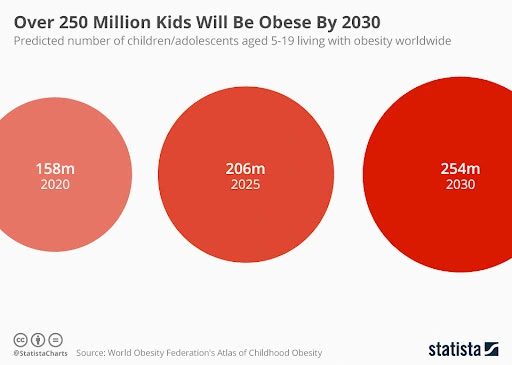
Childhood obesity has been increasing over time and is considered the most challenging healthcare issue of the 21st century. This complex disease is affecting people worldwide, especially in urban areas. According to an estimate, 45 million children under five are overweight.
In recent years, the number of overweight children has doubled around the world. The factors contributing to childhood obesity include unhealthy eating habits, lack of physical activity, and excessive use of fast food.
This increase in the number of overweight children is alarming due to its implications for both health and societal well-being. Overweight children are at a higher risk of experiencing peer teasing, as well as developing issues related to low self-esteem and body image. Addressing childhood obesity demands substantial dedication and effort to help these children regain a healthier weight.
How can Obesity be Diagnosed?
Childhood overweight and obesity represent significant threats to children’s overall well-being. It’s important to recognize that overweight children are at a substantially increased risk of transitioning into overweight adults.

To determine your child’s body mass index (BMI), you can divide their weight in kilograms by the square of their height in meters (kg/m²). For example, if your 10-year-old weighs 102 pounds (equivalent to 46.2 kg) and is 56 inches tall (approximately 1.4 meters), their BMI would be calculated as 23.6 kg/m². This BMI value indicates that they fall into the 95th percentile for BMI for age, signifying that they are classified as having obesity.
Why is Childhood Obesity Problematic?

Childhood obesity poses a significant concern for several reasons. The evidence regarding childhood obesity is certain, with it being a significant public health issue in the United States. According to the CDC, one in every five children in the United States is overweight. Alarmingly, this condition often persists into adulthood.
Children with obesity face a lot of health problems, including:
- Fatty liver
- Cancers, such as colon and breast cancer.
- Stroke.
- High cholesterol.
- Heart disease.
- Diabetes.
- High blood pressure (hypertension).
- Asthma.
- Sleep apnea.
These multifaceted health consequences underscore the significance of addressing childhood obesity as a critical public health priority.
What factors contribute to childhood obesity?
Childhood obesity is a complex issue with various contributing factors. It arises from an energy imbalance, where a child consumes more calories than they expend, leading to the storage of excess calories as fat. Several causes of childhood obesity include:

- Family habits, such as dietary choices and physical activity levels, significantly influence childhood obesity.
- Genetic factors play a role in a child’s susceptibility to obesity, with family history serving as an indicator.
- Factors like access to healthy foods, social support networks, availability of recreational facilities, and neighborhood safety all contribute to the problem.
- Advertising, particularly for unhealthy foods, contributes to childhood obesity.
- Stress can lead to overeating, as the hormone cortisol, released during periods of stress, can trigger hunger and cravings for high-calorie, sugary, or fatty foods.
- While rare, hormone disorders can increase the risk of childhood obesity. However, most cases of childhood obesity are not due to underlying medical conditions.
How to tackle this issue?

Experts suggested some habits that can be useful for the control of obesity and can lead to a healthier life.
- Encourage a variety of fruits and vegetables in every meal and snack.
- Discourage sugary beverages like soda, sweet tea, lemonade, and sports drinks.
- Involve children in grocery shopping and meal preparation to understand their preferences.
- Encourage slow eating, allowing children to recognize hunger and fullness cues.
- Promote family meals, fostering pleasant conversations instead of stress.
- Plan snacks at specific times to avoid continuous snacking, making them nutritious.
- Avoid eating meals or snacks while watching TV to prevent overeating and exposure to unhealthy food ads.
- Promote physical activity by encouraging at least 60 minutes of regular, developmentally appropriate, moderate-to-vigorous intensity activity each day.





